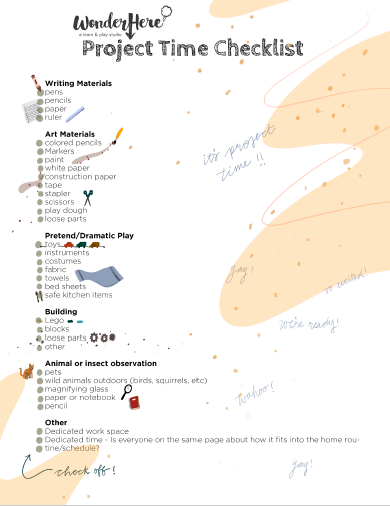Project time is when children are following their own interests and pursuing something they’re passionate about. This can be such an exciting and impactful time of learning! Let’s talk about some project time essentials!
To start out, find out what your children are interested in! You can do this by observing! Watch their play, what they talk about, what they have questions about. Older children will be able to tell you on their own but continue to observe them too! Make time for play! Tinker and explore with no particular agenda. Observe and take notes! Be the scribe for younger children and record their ideas and questions. Brainstorm ways hands on interests can be explored. Help them think about their thinking!
Make sure project materials are available and within reach. You will need to explain how to use (and how not to use!) materials that you provide. Carve out space in your day and in your home to show your kids this is important work. Above all, children feeling ownership of their ideas and passions can lead to beautiful learning.
As your child’s interests take center-stage and their questions and wonders begin to matter and drive instruction, their learning will begin to take shape and learning will come alive for them.
Don’t be nervous, be brave and have faith that your child DOES indeed have wonderful ideas, they CAN think critically, and YES, their questions may seem trivial to you, but THEY MATTER and must be explored fully.
Will it be work? Absolutely! We encourage you to take on the challenge of let- ting your child, even your non-reading 5-year-old, your immature 8 year old, and your unmotivated tween; we challenge you to let them DO and THINK and QUESTION and FIGURE IT OUT. What do you have to gain? Everything! What IF this crazy PBL journey leads you down the path towards finding the joy in watching your child discover their own abilities, grow in independence, and recognize that they too have wonderful ideas? Is it worth it? You better believe it!
The following are important reminders when implementing project-time. These thoughts are directly quoted from various sections of Eleanor Duckworth’s book “The Having of Wonderful Ideas: And Other Essays on Teaching and Learning”:
The right question at the right time can move children to peaks in their thinking that result in significant steps forward and real intellectual excitement.
Although it is impossible for an adult to know exactly the right time to ask a specific question of a specific child, children can raise the right question for themselves if the setting is right.
Why do so few continue to have their own wonderful ideas? I think part of the answer is that intellectual break- throughs come to be less and less valued. Either they are dismissed as being trivial, or else they are discouraged as being unacceptable.
Work closely with your child 1:1 and try to figure out what is really in your child’s mind Wonderful ideas do not spring out of nothing. They build on a foundation of other ideas. Knowing enough about things is one prerequisite for wonderful ideas.
How to Create a Project Friendly Learning Environment
Provide a setting that suggests wonderful ideas to children- different ideas to different children- as they are caught up in intellectual problems that are real to them.
The best one can do is to make such knowledge, such familiarity, seem interesting and accessible to the child. That is, one can familiarize children with a few phenomena in such a way as to catch their interest, to let them raise and answer their own questions, to let them realize that their ideas are significant so that they have the interest, the ability, and the self-confidence to go on by themselves.
Provide examples that are extraordinary as to what a child might do but not what they are likely to do or what they should do.
Children will improve at having ideas of what to do, at raising questions, and at answering their own questions; that is, at having their own ideas and being confident about their own ideas (with more experience and when provided opportunities).
Check out this beautifully curated and designed Project Time Checklist full of materials you can use and a Simplified Guide to Loose Parts!
We would love to see how project time is going for your family! If you use social media, post pictures of your children using the hashtag #wewonderhere so that other families can be encouraged that project time is meaningful time that can happen in their home, too! And, if you are on Instagram, be sure to follow WonderHere and check out our latest IGTV Episode: TNL: Project Time with Leslie Martino to learn an in-depth understanding on how to incorporate project time into your home and homeschool.
You are awesome! May your day be WONDERful and your project-time fun!





